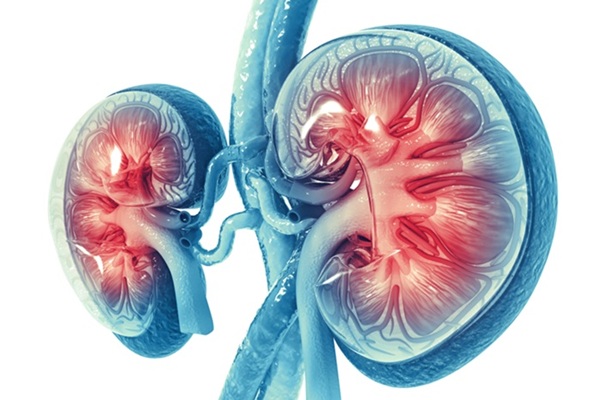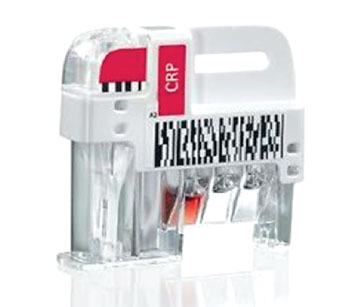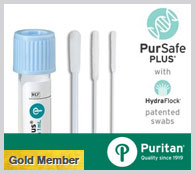Quick Test Minimizes Unnecessary Primary Care Antibiotic Prescribing
|
By LabMedica International staff writers Posted on 19 Oct 2015 |
C-reactive protein (CRP) is a biomarker in blood which indicates the presence of inflammation, and the amount of CRP in the body gives an indication of the severity of an infection. Low levels of CRP are indicative of viral or self-limiting bacterial infections, and high levels indicate serious infection.
Almost 80% of antibiotics are prescribed in primary care and respiratory tract infections (RTIs) are the reason for 60% of these antibiotic prescriptions. The vast majority of these infections are self-limiting or caused by viruses in which case antibiotics have little or no clinical benefit for patients. C-reactive protein point of care testing (CRP POCT) has successfully helped to identify patients who did not require antibiotics, when presenting with symptoms of RTIs.
A study that was recently conducted that included 99 patients, aged 5 to 75 years who visited their general practitioner (GP) with a chesty cough. After undergoing a clinical scoring system, each patient's CRP levels were measured at the point of care using the Afinion CRP test, a rapid in vitro diagnostic assay for quantitative determination of CRP (Alere; Waltham, MA, USA). Only 13% of these patients needed antibiotic treatment as the CRP POCT had concluded higher CRP levels. Within one month, 17% of the 99 patients returned to the surgery and only 5% were prescribed antibiotics.
The study also provides insights on patients' expectations of receiving antibiotics. All participants had to complete a questionnaire in which they were asked whether they expected to receive antibiotics for their symptoms. Of the 26 patients expecting to receive antibiotics, only seven (27%) patients received them. Additionally, patients with lower CRP levels, who therefore would not have been suitable for antibiotics, were more likely to expect an antibiotic when asked.
CRP POCT takes less than five minutes from a finger stick blood sample to provide a quantitative result and helps to facilitate an effective conversation between patients and GPs around the rational use of antibiotics. The CRP POCT is already used in routine management in several European countries to aid diagnosis in suspected RTI and guide decision making regarding antibiotic prescribing.
Rob Cook, MD, who was involved in the study and a GP from London, said, “This study was conducted to see how feasible and useful CRP POCT is in real world general practice. We found that the test could be easily incorporated into routine care and provided very useful information for GPs and patients presenting with a cough. The vast majority of patients were reassured by a low CRP level and did not receive antibiotics.” The study was presented at the Royal College of General Practitioners (RCGP) Annual Conference held October 1-3, 2015, in Glasgow (UK).
Related Links:
Alere
Almost 80% of antibiotics are prescribed in primary care and respiratory tract infections (RTIs) are the reason for 60% of these antibiotic prescriptions. The vast majority of these infections are self-limiting or caused by viruses in which case antibiotics have little or no clinical benefit for patients. C-reactive protein point of care testing (CRP POCT) has successfully helped to identify patients who did not require antibiotics, when presenting with symptoms of RTIs.
A study that was recently conducted that included 99 patients, aged 5 to 75 years who visited their general practitioner (GP) with a chesty cough. After undergoing a clinical scoring system, each patient's CRP levels were measured at the point of care using the Afinion CRP test, a rapid in vitro diagnostic assay for quantitative determination of CRP (Alere; Waltham, MA, USA). Only 13% of these patients needed antibiotic treatment as the CRP POCT had concluded higher CRP levels. Within one month, 17% of the 99 patients returned to the surgery and only 5% were prescribed antibiotics.
The study also provides insights on patients' expectations of receiving antibiotics. All participants had to complete a questionnaire in which they were asked whether they expected to receive antibiotics for their symptoms. Of the 26 patients expecting to receive antibiotics, only seven (27%) patients received them. Additionally, patients with lower CRP levels, who therefore would not have been suitable for antibiotics, were more likely to expect an antibiotic when asked.
CRP POCT takes less than five minutes from a finger stick blood sample to provide a quantitative result and helps to facilitate an effective conversation between patients and GPs around the rational use of antibiotics. The CRP POCT is already used in routine management in several European countries to aid diagnosis in suspected RTI and guide decision making regarding antibiotic prescribing.
Rob Cook, MD, who was involved in the study and a GP from London, said, “This study was conducted to see how feasible and useful CRP POCT is in real world general practice. We found that the test could be easily incorporated into routine care and provided very useful information for GPs and patients presenting with a cough. The vast majority of patients were reassured by a low CRP level and did not receive antibiotics.” The study was presented at the Royal College of General Practitioners (RCGP) Annual Conference held October 1-3, 2015, in Glasgow (UK).
Related Links:
Alere
Read the full article by registering today, it's FREE! 

Register now for FREE to LabMedica.com and get access to news and events that shape the world of Clinical Laboratory Medicine. 
- Free digital version edition of LabMedica International sent by email on regular basis
- Free print version of LabMedica International magazine (available only outside USA and Canada).
- Free and unlimited access to back issues of LabMedica International in digital format
- Free LabMedica International Newsletter sent every week containing the latest news
- Free breaking news sent via email
- Free access to Events Calendar
- Free access to LinkXpress new product services
- REGISTRATION IS FREE AND EASY!
Sign in: Registered website members
Sign in: Registered magazine subscribers
Latest Microbiology News
- Fast Noninvasive Bedside Test Uses Sugar Fingerprint to Detect Fungal Infections
- Rapid Sepsis Diagnostic Device to Enable Personalized Critical Care for ICU Patients
- Microfluidic Platform Assesses Neutrophil Function in Sepsis Patients
- New Diagnostic Method Confirms Sepsis Infections Earlier
- New Markers Could Predict Risk of Severe Chlamydia Infection
- Portable Spectroscopy Rapidly and Noninvasively Detects Bacterial Species in Vaginal Fluid
- CRISPR-Based Saliva Test Detects Tuberculosis Directly from Sputum
- Urine-Based Assay Diagnoses Common Lung Infection in Immunocompromised People
- Saliva Test Detects Implant-Related Microbial Risks
- New Platform Leverages AI and Quantum Computing to Predict Salmonella Antimicrobial Resistance
- Early Detection of Gut Microbiota Metabolite Linked to Atherosclerosis Could Revolutionize Diagnosis
- Viral Load Tests Can Help Predict Mpox Severity
- Gut Microbiota Analysis Enables Early and Non-Invasive Detection of Gestational Diabetes
- Credit Card-Sized Test Boosts TB Detection in HIV Hotspots
- Fecal Metabolite Profiling Predicts Mortality in Critically Ill Patients
- Portable Molecular POC System Rules Out UTIs in Just 35 Minutes
Channels
Clinical Chemistry
view channel
VOCs Show Promise for Early Multi-Cancer Detection
Early cancer detection is critical to improving survival rates, but most current screening methods focus on individual cancer types and often involve invasive procedures. This makes it difficult to identify... Read more
Portable Raman Spectroscopy Offers Cost-Effective Kidney Disease Diagnosis at POC
Kidney disease is typically diagnosed through blood or urine tests, often when patients present with symptoms such as blood in urine, shortness of breath, or weight loss. While these tests are common,... Read moreMolecular Diagnostics
view channel
Urine Test Could Replace Painful Kidney Biopsies for Lupus Patients
Lupus is an autoimmune disorder that causes the immune system to attack the body’s own tissues and organs. Among the five million people living with lupus globally, nearly half develop lupus nephritis,... Read more
Blood Test Guides Post-Surgical Immunotherapy for Muscle-Invasive Bladder Cancer
After surgery for muscle-invasive bladder cancer, many patients face uncertainty about whether residual cancer cells remain in their bodies. Now, a new international phase 3 study has demonstrated that... Read more
Mitochondrial DNA Mutations from Kidney Stressors Could Predict Future Organ Decline
Kidney-related diseases are alarmingly common: chronic kidney disease (CKD) affects more than one in seven U.S. adults, while about 20% of hospitalized adults are diagnosed with acute kidney injury (AKI).... Read moreHematology
view channel
Viscoelastic Testing Could Improve Treatment of Maternal Hemorrhage
Postpartum hemorrhage, severe bleeding after childbirth, remains one of the leading causes of maternal mortality worldwide, yet many of these deaths are preventable. Standard care can be hindered by delays... Read more
Pioneering Model Measures Radiation Exposure in Blood for Precise Cancer Treatments
Scientists have long focused on protecting organs near tumors during radiotherapy, but blood — a vital, circulating tissue — has largely been excluded from dose calculations. Each blood cell passing through... Read more
Platelets Could Improve Early and Minimally Invasive Detection of Cancer
Platelets are widely recognized for their role in blood clotting and scab formation, but they also play a crucial role in immune defense by detecting pathogens and recruiting immune cells.... Read more
Portable and Disposable Device Obtains Platelet-Rich Plasma Without Complex Equipment
Platelet-rich plasma (PRP) plays a crucial role in regenerative medicine due to its ability to accelerate healing and repair tissue. However, obtaining PRP traditionally requires expensive centrifugation... Read moreImmunology
view channel
Signature Genes Predict T-Cell Expansion in Cancer Immunotherapy
Modern cancer immunotherapies rely on the ability of CD8⁺ T cells to rapidly multiply within tumors, generating the immune force needed to eliminate cancer cells. However, the biological triggers behind... Read more
Molecular Microscope Diagnostic System Assesses Lung Transplant Rejection
Lung transplant recipients face a significant risk of rejection and often require routine biopsies to monitor graft health, yet assessing the same biopsy sample can be highly inconsistent among pathologists.... Read morePathology
view channel
Tears Offer Noninvasive Alternative for Diagnosing Neurodegenerative Diseases
Diagnosing and monitoring eye and neurodegenerative diseases often requires invasive procedures to access ocular fluids. Ocular fluids like aqueous humor and vitreous humor contain valuable molecular information... Read more
AI-Powered Method Combines Blood Data to Accurately Measure Biological Age
Chronological age tells us how many years we’ve lived, but not how quickly our bodies are ageing. Some people stay healthy well into their 80s or 90s, while others experience decline much earlier.... Read moreTechnology
view channel
Viral Biosensor Test Simultaneously Detects Hepatitis and HIV
Globally, over 300 million people live with Hepatitis B and C, and 40 million with HIV, according to WHO estimates. Diagnosing bloodborne viruses such as HIV and Hepatitis B and C remains challenging in... Read more
Acoustofluidic Device to Transform Point-Of-Care sEV-Based Diagnostics
Rapid and sensitive detection of small extracellular vesicles (sEVs)—key biomarkers in cancer and organ health monitoring—remains challenging due to the need for multiple preprocessing steps and bulky... Read moreIndustry
view channel
Advanced Instruments Merged Under Nova Biomedical Name
Advanced Instruments (Norwood, MA, USA) and Nova Biomedical (Waltham, MA, USA) are now officially doing business under a single, unified brand. This transformation is expected to deliver greater value... Read more












 (3) (1).png)










